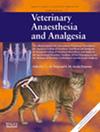The effect of midazolam co-induction on cardiorespiratory variables, myoclonus and etomidate dose requirements in healthy cats
IF 1.9
2区 农林科学
Q2 VETERINARY SCIENCES
引用次数: 0
Abstract
Objective
To evaluate dose requirements of etomidate for endotracheal intubation, with or without midazolam co-induction, and to describe induction quality and associated cardiorespiratory variables in healthy cats.
Study design
Randomized prospective experimental study.
Animals
A group of 24 adult neutered cats (17 females, seven males).
Methods
Cats were premedicated with intramuscular butorphanol (0.4 mg kg–1) and alfaxalone (2 mg kg–1), and anesthesia was induced with etomidate following midazolam (0.3 mg kg–1) or physiologic saline (0.06 mL kg–1) intravenously. Heart rate, respiratory rate (fR) and arterial blood pressure were measured following premedication, at co-induction, after etomidate administration, and after orotracheal intubation and compared using repeated-measures anova. Pre- and post-etomidate blood samples were assessed for the presence of hemolysis. Etomidate dose requirements and prevalence of myoclonus were compared with Wilcoxon signed ranks test and Fisher’s test. Values of p < 0.05 were considered significant.
Results
Mean ± standard deviation etomidate doses required for orotracheal intubation were 0.84 ± 0.26 and 1.39 ± 0.33 mg kg–1 for midazolam and saline co-induction, respectively (p = 0.001). The presence of myoclonus at sedated baseline, co-induction and etomidate was 6/12, 8/12 and 9/12 in the saline group, respectively, and 10/12, 2/12 and 0/12 in the midazolam group. The prevalence of myoclonus was lower in the midazolam group after co-induction and etomidate injection (p = 0.036 and p < 0.001, respectively). Cardiorespiratory variables did not differ between groups at any time point. Compared with baseline, fR decreased in both groups after etomidate injection and intubation. Hemolysis was observed in all post-etomidate plasma samples.
Conclusions and clinical relevance
Etomidate, with or without midazolam co-induction, provides acceptable cardiovascular function in premedicated healthy cats. Midazolam reduces etomidate requirements for orotracheal intubation and improves induction quality in cats premedicated with intramuscular butorphanol–alfaxalone.
咪达唑仑共诱导对健康猫心肺变量、肌阵挛和依托咪酯剂量需求的影响。
目的:评价咪达唑仑联合诱导或不联合诱导时依托咪酯用于气管插管的剂量要求,并描述诱导质量和相关的心肺变量。研究设计:随机前瞻性实验研究。动物:一组24只成年绝育猫(17只母猫,7只公猫)。方法:猫先肌内注射布托啡诺(0.4 mg kg-1)和阿法索龙(2 mg kg-1),咪达唑仑(0.3 mg kg-1)或生理盐水(0.06 mL kg-1)后静脉注射依托咪酯诱导麻醉。分别在用药前、共诱导、依托咪酯给药后和经气管插管后测量心率、呼吸率(fR)和动脉血压,并采用重复测量方差分析进行比较。使用依托咪酯前后的血液样本被评估是否存在溶血。采用Wilcoxon sign ranks检验和Fisher检验比较依托咪酯的剂量要求和肌阵挛的发生率。p < 0.05为显著性。结果:咪达唑仑和生理盐水共诱导气管插管所需依托咪酯剂量的平均值±标准差分别为0.84±0.26和1.39±0.33 mg kg-1 (p = 0.001)。生理盐水组在镇静基线、共诱导和依托咪酯时肌晕的出现率分别为6/12、8/12和9/12,咪达唑仑组为10/12、2/12和0/12。咪达唑仑组与依托咪酯组共诱导后肌阵挛发生率较低(p = 0.036, p < 0.001)。在任何时间点,两组之间的心肺变量均无差异。与基线相比,注射依托咪酯和插管后两组fR均下降。所有服用依托咪酯后的血浆样本均出现溶血现象。结论及临床意义:依托咪酯与或不与咪达唑仑共诱导,可为预先用药的健康猫提供可接受的心血管功能。咪达唑仑减少了经气管插管对依托咪酯的需求,并改善了预先肌注布托啡诺-阿尔法霉素的猫的诱导质量。
本文章由计算机程序翻译,如有差异,请以英文原文为准。
求助全文
约1分钟内获得全文
求助全文
来源期刊

Veterinary anaesthesia and analgesia
农林科学-兽医学
CiteScore
3.10
自引率
17.60%
发文量
91
审稿时长
97 days
期刊介绍:
Veterinary Anaesthesia and Analgesia is the official journal of the Association of Veterinary Anaesthetists, the American College of Veterinary Anesthesia and Analgesia and the European College of Veterinary Anaesthesia and Analgesia. Its purpose is the publication of original, peer reviewed articles covering all branches of anaesthesia and the relief of pain in animals. Articles concerned with the following subjects related to anaesthesia and analgesia are also welcome:
the basic sciences;
pathophysiology of disease as it relates to anaesthetic management
equipment
intensive care
chemical restraint of animals including laboratory animals, wildlife and exotic animals
welfare issues associated with pain and distress
education in veterinary anaesthesia and analgesia.
Review articles, special articles, and historical notes will also be published, along with editorials, case reports in the form of letters to the editor, and book reviews. There is also an active correspondence section.
 求助内容:
求助内容: 应助结果提醒方式:
应助结果提醒方式:


